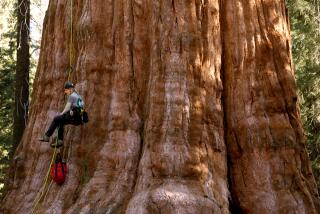Hidden Old-Growth Forest in Georgia Provides Intriguing Glimpse of 16th Century
- Share via
THOMASVILLE, Ga. — The secret preserve that contains some of the Southeast’s last remaining old-growth forest is silent except for the occasional twittering of birds and the rustling of wind through gnarled pine boughs.
Known as the Wade Tract, the 200-acre forest is one of only a handful of sites in the Southeast that has remained virtually unchanged since at least the early 1500s, when Spaniard Hernando DeSoto explored the region.
“Without this site and perhaps two or three others that begin to approach it in quality, we have no way to assess how far our managed lands have diverted” from their natural state, said Sharon Hermann, a plant biologist at the Tall Timbers Research Station, which manages the preserve. “This is the site that probably comes closest to approximating what DeSoto saw.”
The Wade Tract has about 400 plant species, including wiregrass, small oaks and 350-year-old longleaf pine trees. It is a home for about 60 species of mammals, reptiles, amphibians and birds, including quail and endangered red cockaded woodpeckers.
Scientists from Tall Timbers, a privately funded research group near Tallahassee, Fla., are learning about the plants and animals that lived in old-growth forests. They also are studying the effects of forest fires, an essential element of the ecology.
Knowledge gained at the preserve could be used to restore public and private lands to a more natural state and to create future land-management guidelines.
When Europeans began colonizing North America in the 1600s, there were an estimated 60 million to 70 million acres of longleaf pines in the coastal plain, which stretches from the Carolinas to Texas.
But now, because of logging, farming and urbanization, only about 2,000 acres of old growth--about three square miles--survive, said Todd Engstrom, a Tall Timbers ornithologist.
“It’s one of the most endangered ecosystems in the Southeastern United States,” Engstrom said. “This is one of the few places where it is still in a relatively natural state and we can study it.”
The tract is located near Thomasville, a southwest Georgia town surrounded by plantations. Many of the private estates are quail-hunting preserves.
The exact location of the Wade Tract is a closely guarded secret.
Only about 150 people visit the site a year, most of whom are scientists or forest managers.
Tall Timbers is essentially a prairie with wiregrass and pines. It needs periodic fires to keep the turkey oak and runner oak from turning it into a hardwood forest, said Leonard Brennan, Tall Timbers’ research director.
The trees are randomly spaced on the hilly land with lots of sunny, open spaces for grasses, flowers and wild legumes.
Most of the pines, many about 80 feet tall and three feet in diameter at the trunk, have red-heart disease, a fungal disease that softens the heartwood. Red cockaded woodpeckers need such trees to bore their cavities and make nests.
Forest fires can occur naturally from lightning, but fires are not left to chance at the tract. Portions are set ablaze every May and June to mimic natural conditions.
Tall Timbers has a 99-year agreement with the owner, a New England attorney, to keep the preserve in a natural state. Researchers cannot move downed trees or remove plants for study. The agreement began in 1977.
They hope to develop a forest-management plan that can be used in state and national forests and in wildlife refuges.
All of the Wade Tract’s 13,000 longleaf pines, including seedlings, are marked with metal tags and their coordinates are plotted on a map. All other plants with stems larger than 1 1/2 inches are also plotted on the map.
“What we need to know, and what the Wade Tract provides better than just about any other place, is how the forest changes over time and how the species interact with each other and with fire,” Hermann said. “The Wade Tract has not only the old trees, but also the ground cover and the timing of the fire.”
More to Read
Sign up for Essential California
The most important California stories and recommendations in your inbox every morning.
You may occasionally receive promotional content from the Los Angeles Times.













